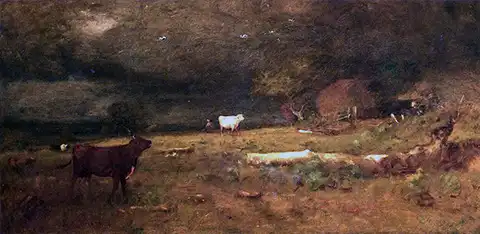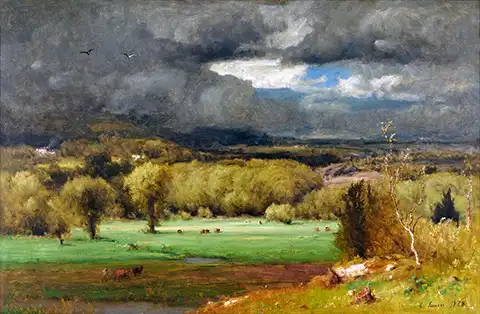American Landscape Painter
In the nexus between realism and impressionism live the paintings of George Innes, American landscape painter (May 1, 1825 – August 3, 1894.) Initially influenced by the Hudson River painters George Innes was interested in the spiritual force of nature and tried to represent this in his paintings. While the Hudson River painters strived to recreate nature as accurately as possible, Innes was less concerned with visible detail and more concerned with the power of nature through atmosphere and the emotion of the scene. There is often a lone figure in the paintings illustrating the scale of nature against man.

Light and Dark
A recurring subject of his, the Storm, illustrates this spiritual force of nature brilliantly. Animals and man bracing for the coming onslaught. Chaotic black skies, with belts of sunlight still illuminating the ground. George Innes employed clever compositional use of shadow to emphasize the subject matter of the painting. In The Storm, 1878, our eyes are immediately drawn to a bright green field sandwiched between an ominous cloudy sky and a shadowed foreground. In The Coming Storm, 1893 the almost black, swirling background and dark bleating livestock in the foreground serve to highlight the elements ensconced in light.

Gestural and Detailed
The most interesting paintings use a variety of brush strokes and paint application. Innes constructed soft, blurred areas and more intricate, detailed oriented brushwork to great effect.

Dynamic Composition
In your own paintings create a more dynamic artwork by asking yourself a few questions:
- Do all my marks or brush strokes looks similar? Use a variety of different brush types and sizes.
- Is there enough contrast in my colors? Increase the gap in values of your colors – Make the darkest color darker and lightest color lighter.
- Are there compositional elements I can add to increase a sense of dimensional space? This could be as simple as changing the color values of the foreground and background or highlighting an object to lead the viewer’s eye in a certain direction.
